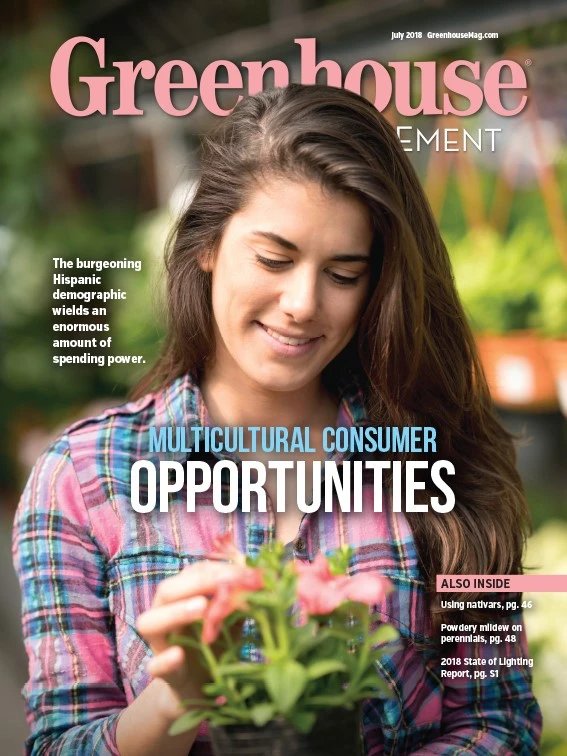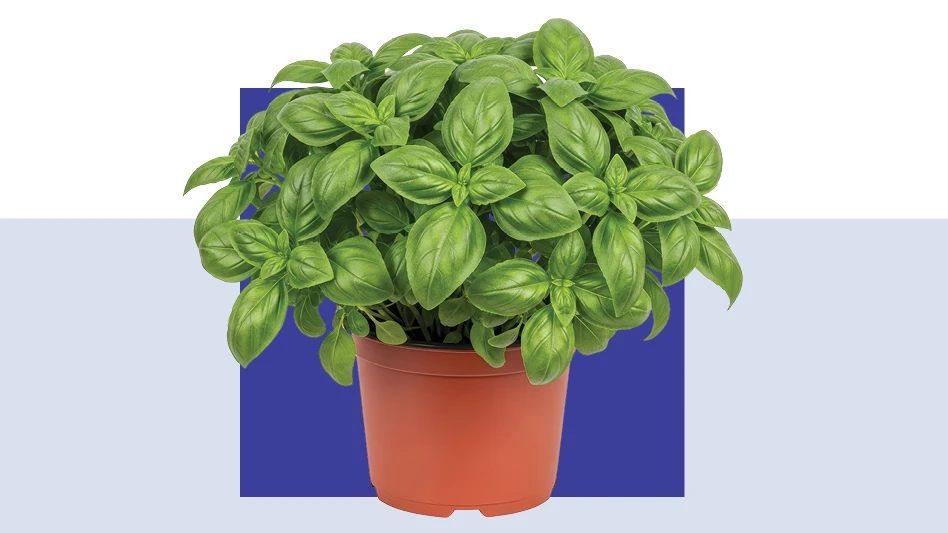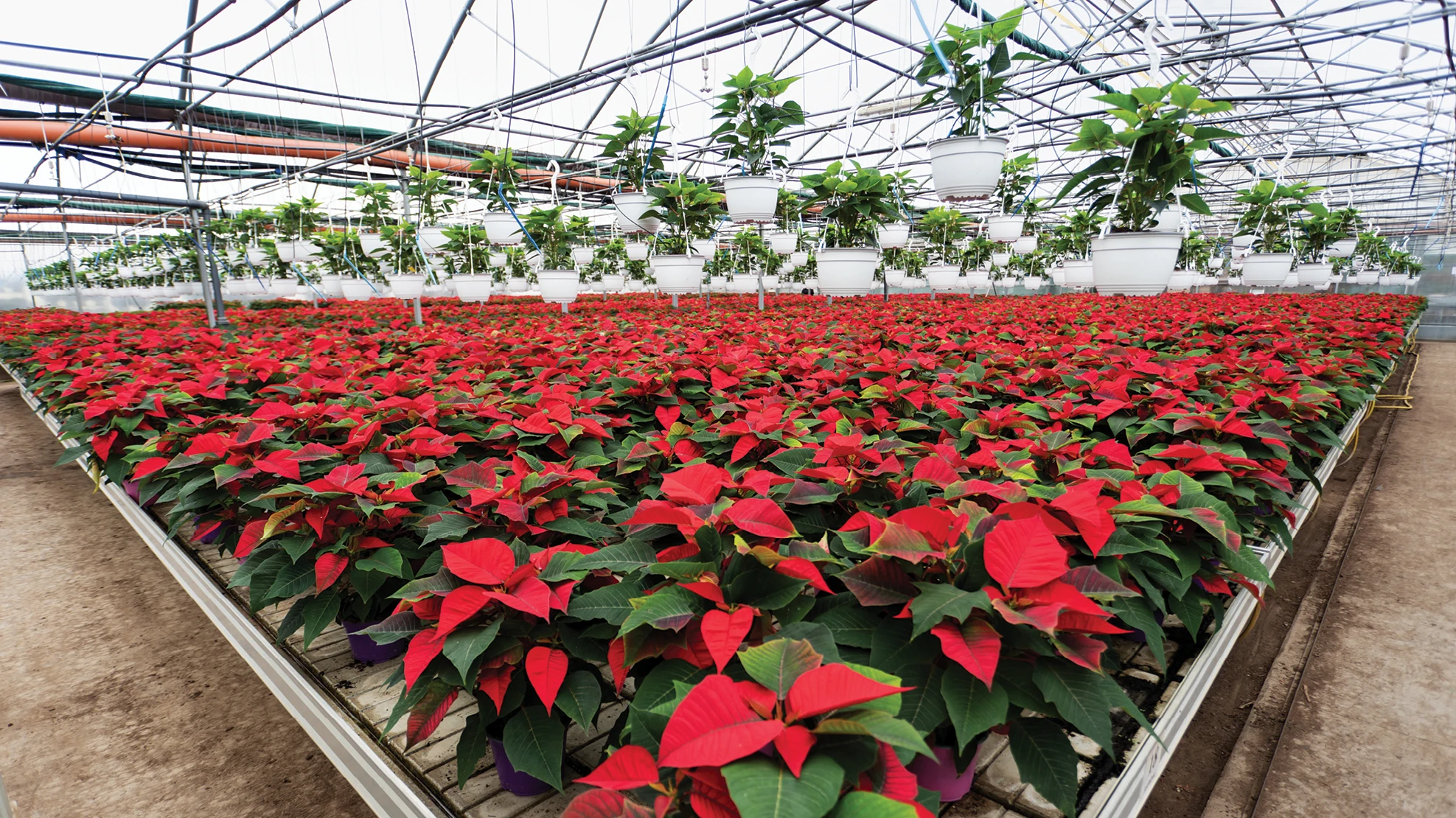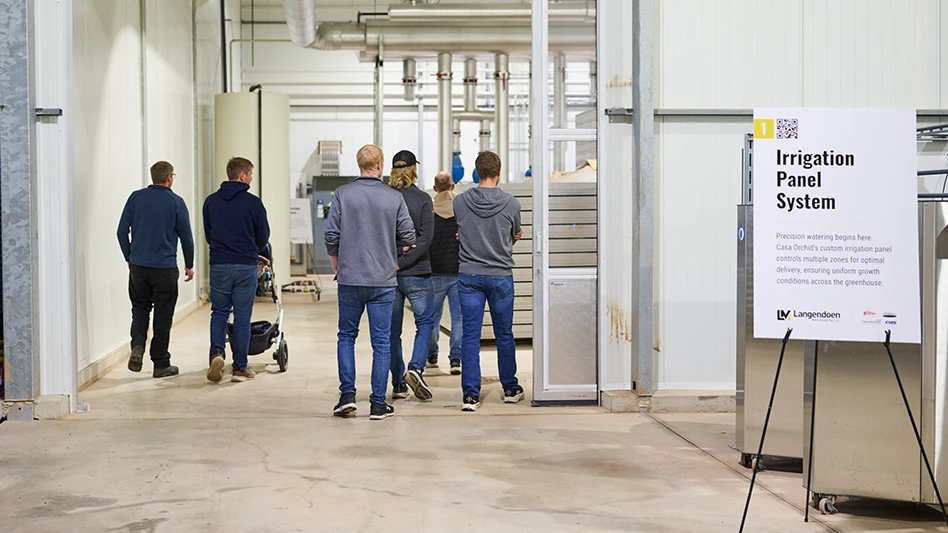
As the oldest of three siblings, and part of the third generation at Jeffery’s Greenhouses, it seemed inevitable that Barbara Jeffery-Gibson would find her way back to the family business. However, Barb’s passions took her in a different direction, and she headed to Toronto after high school to study fashion merchandising at the Ryerson School of Fashion. But her path wasn’t set in stone quite yet, and she would eventually return to Jeffery’s. “I was the least likely to be involved, and now I’m the most involved,” Barb says.
Farming, then flowers
In 1933, George and Anne Jeffery, Barb’s grandparents, purchased a farm in St. Catharines that was the family’s first foray into horticulture. “It was more like a fruit and vegetable farm,” Barb says. When Barb’s father, Jim Jeffery, was a teenager, he suggested adding greenhouses and flower production to the business. By the time he was 16, Jim was 50 percent owner of the business, and the company’s name was changed to George Jeffery & Son Greenhouses in 1965. A few years later, Jim married Sandy, Barb’s mother. “They really built the business together,” Barb says. “So much so that my grandfather gifted his shares to my mother [in 1982] so that my parents were [each] 50 percent owners in the business.” At this point, the name was changed to Jeffery’s Greenhouses, Inc.
Barb and her two younger siblings, Kim and Jim Jr. or Jimmy, grew up in the greenhouse, and were an integral part of the family business. “When you grow up in a family farm or greenhouse business, there are seasonal times of year that you’re so busy and everybody has got to pitch in, including your kids,” Barb’s father Jim says. Barb remembers working in the greenhouse any time they were off school. “We were brought up in the greenhouse, helping out where we could,” Barb says. “I had probably done most of the jobs in the greenhouse, and I’ll joke that I probably wasn’t the quickest on all of the jobs, maybe not loving it as much as somebody else might have.”
Jim picked up on that, too. “Barb was the one that least liked getting her hands dirty. She was willing to do some of the jobs, but she wasn’t too keen on that,” he says.
Fashion or flowers?
After high school, Barb dove into her fashion merchandising studies at Ryerson. Sandy says she could see a difference in Barb as she progressed through her studies. “She really learned discipline and leadership [there],” Sandy says. “She’d be up until all hours of the night getting a fashion show ready for the next day. Just the discipline you had to have to do that, she must have absolutely loved it because she worked so hard at it and it paid off for her.”
Barb continued to come home on her breaks and work for the family business, and the timing proved serendipitous. “It wasn’t until [I went away to university] that I finished school within a time frame that I was able to work in the greenhouse and actually see the busy rush of our business, so that sparked my interest — that never happened before,” she says. “I came home [in the] middle of April and tried working in the office instead of in the greenhouse.” By the second year of doing this, Barb says she was essentially running the sales office during that time. “I found a passion for wanting to put my stamp on things, set some goals and change the way the business was,” she says. “I found confidence in what I was doing and I was very driven to, coming out of school, have my own space to carve out my own path.”
At this point, Barb was sure that working at Jeffery’s was in her future. “I decided to finish the third and fourth year [of university] and then come back,” Barb says. “I wanted to have that accomplishment, and I really did like the course I was in.”
Not everyone expected Barb to come back into the business. Her parents had always encouraged their children to “go do something different,” as Barb puts it. “We thought she would stay in Toronto [when] she was offered jobs just out of school,” Sandy says. “She turned them down. We thought for sure she’d be somewhere like New York or Chicago or Toronto — one of the big metropolitan cities. She chose home, and we’re very happy for her, and I know she loves doing what she’s doing here.”
“It really was a surprise to me as well, because it wasn’t really where I thought I would be,” Barb says. Now, 25 years later, she knows that her path took her right back to where she needed to be.

25 years of relationships
Currently, Barb oversees sales, administration and growing as president/co-owner of the company. She works with her husband Rodd, who is the general manager and works at their other greenhouse location. “Rodd has been a very integral part of our business,” she says. Jim says that he learned from working with his wife Sandy that it can be beneficial to have both spouses working at the same place. “It’s almost better for you to understand each other’s daily challenges, to appreciate each other and work together toward a common goal,” he says. “I believe [Barb and Rodd] enjoy the fact that they’re working together.”
The horticulture industry has treated Barb well over the past 25 years. “People in this industry have an appreciation for plants and flowers for sure, but the people are what make [the industry] interesting,” she says. Jeffery’s Greenhouses works with a small group of contract growers, which Barb enjoys because she’s able to get out and see other greenhouses and new faces. “I don’t think there are too many people in this industry that I have met that haven’t been very friendly,” she says.
It’s also a sharing industry, in Barb’s opinion. “There are different relationships where it’s more competitive and maybe you’re not an open book, but there’s always something that you can share with each other for everyone to be more successful,” she says.
“Barb is also actively encouraging different members of our team here at Jeffery’s to participate in industry organizations and in efforts to educate young horticulturists,” says Albert Grimm, Jeffery’s Greenhouses’ head grower. “To this end, it is important to note that Barb supports the sharing of some proprietary information when it benefits all of the industry.”
The relationships that she’s developed over the years have been vital to her accomplishments. “I truly believe that a large part of the success I’ve had has been due to the relationship-building I continue to incorporate into everything I do,” Barb says.
Prior to working exclusively with Home Depot, as they do now, Jeffery’s main customer was White Rose Crafts and Nursery Sales. Barb says that she considers the White Rose buyer, Erica Metcalfe, to be one of her early mentors. “She embraced the fact that I was young, enthusiastic and passionate about [horticulture] and was willing [to learn],” Barb says.
When White Rose filed for Chapter 11 bankruptcy in 2002, it was bad news for Jeffery’s — but not as bad as it could’ve been. “We had a lot of eggs in the basket with White Rose and then they filed Chapter 11 and we had to quickly change things,” Barb explains. However, because of the strong relationship they had with White Rose, Jeffery’s requested and received prepayment for their plants before the company went under. Other suppliers weren’t as lucky.

An industry mentor
The relationships Barb has built have also included mentorships. Barb has served as a mentor to Niki Radke, who has worked with Barb in the sales department since 2004. She says Barb took her under her wing and kickstarted her career in the horticulture industry. “I really don’t know where I would be if Barb did not open her doors to me. The skills and leadership she has shown me [have] impacted my life and play a huge part of who I am today as a young woman in the industry,” Niki says. “She has been an amazing mentor to me and has given me life-changing opportunities that I will be forever grateful for.”
And Niki looks up to Barb on a personal level, too. “I can truly say Barb is the Princess Diana of the horticultural industry,” Niki says. “Anyone who has had the opportunity to work with her or meet her would say the same. She always greets you with a smile. She is humble, kind, gracious, inspiring, strong, courteous and resilient like no other. She is very well-liked and respected in the industry. Not to mention she has amazing fashion sense.”
Barb was just beginning to take on a leadership role and implement her unique vision for Jeffery’s when she hired Albert Grimm to her production team. However, she didn’t hire Albert to fill a pre-determined position, instead offering him the opportunity to develop his role as he worked with the existing team and implemented a new form of greenhouse growing. Looking back, Albert says that “was a brilliant idea.” He says he desperately needed a platform to apply his knowledge, and this was it.
“When I started working for Jeffery’s Greenhouses, I was quite frankly frustrated with our entire profession and with its lack of opportunity for ambitious specialists to develop meaningful careers,” Albert says. “For me, it was a stroke of luck to get hired by Barb and to be able to work with the fantastic team that she has created here at the company. Barb has not only provided me with the opportunity to unfold the career that I was seeking, but she has actively encouraged my professional and personal development.” He says that since then, he has worked each day to provide plant material at the quality and time that fulfills Barb’s market plans.

A born leader
Sandy Jeffery can remember examples of Barb’s leadership dating all the way back to primary school, when Barb would be the teacher if she was playing school with her friends. When she was 15 and in high school, Barb led a ski trip to Quebec City. “She hired the bus and did the advertising with her friend and they got everything together,” Sandy recalls.
After the trip, Sandy says that the bus company called to say that they wouldn’t refund her deposit because of some damage — gum on the seats or something of the like. “I sensed that there was a problem on the other end, and I stood beside her and said, ‘Let me talk to them,’” Sandy recalls. “And she waved her hand at me [to] get away, [she would] talk to them. I’ll never forget that, because that’s what Barb is like. If there’s a problem, she deals with it herself. She never passes it on to anybody else. And the thing is, she’s very capable of doing it. She handles it so well. Pretty much everyone [at the company] turns to her.”
At Jeffery’s, Barb takes charge as needed, but also lets her staff do their jobs without micromanaging and carve their own path to achieving their goals. “We give them some direction, but we really allow them to do the job that we’ve hired them to,” she says. “Sometimes that works for the people that we’ve hired and sometimes it doesn’t work.” For Albert, this method works well. “Barb’s management style fosters excellence at every level and she is very conscientious about recognizing and rewarding dedication to the tasks and goals of the company,” he says.
Albert says that Barb has very high expectations for product quality and program execution, but her goals are achievable because of the support that the staff receives. “The team at Jeffery’s works with high benchmarks, and we are fully supported to bring our capacity to effect in reaching these benchmarks,” he says. “There are very few companies that implement this principle as authentically as Jeffery’s. It is not just lip-service. Passion for greenhouse production is a job requirement, and it is very rewarding for all of us to be able to live this passion.”
Another key to Barb’s management success is her preference for direct, face-to-face communication, even when an email might be easier. “[I prefer] dealing with things directly and being honest about them, whether good or bad,” she says. “Communication is key for everything. Over-communicating something is better than under-communicating.” She cautions managers against only sending an email if a matter needs to be dealt with, because they’re working with people in the greenhouse who may not be checking their email regularly. Also, “sometimes it’s easier to explain over the phone or in-person, particularly if your news isn’t going to sit well with the person.” In the latter case, “You’re better to deal with it in person,” she says.
Overall, she says that the key staff at Jeffery’s is very capable, and she lets them do what they do best. “They’re passionate about what they do, they have a strong sense of ownership and pride in what they contribute, and really we’re very fortunate to have good people in those key positions,” she says. Albert says that Barb, who is a “brilliant expert in the marketing of plants, but not a horticulturist,” doesn’t interfere with day-to-day production matters so long as the growing team is executing production plans as expected. “This is an important reason for the success of the company, because it allows all the production experts to do their work to their full capacity,” he says.


Fashion meets flowers
When she’s not managing staff, Barb enjoys working on the more creative side of the business. She’s always had a flair for fashion and was excited to see how much of her fashion background could be incorporated into her current role. “I was surprised coming out of school how much I could apply,” she says. “Something that I still enjoy doing today is making all of our mixed planter combinations. I don’t think I would be out of line saying I was a bit of a pioneer back then with making the different mixed plant combinations, in terms of unique designs and incorporating things that work well together.”
Niki says that she has seen first-hand how Barb has used her fashion and design education to identify global trends that could be transferred to the North American market. “She is a strategic member on the grower counsels of our major big-box customer,” Niki says. “Her educational background in fashion arts has made her one of the go-to persons on these counsels when choosing floral and container combinations.”
Barb tries to bring excitement and new mixes each year to their offerings. She says that the incorporation of more textures and different foliage into combinations is trending now, as is adding tropicals.

Courtesy of Barbara Jeffery-Gibson & Sandy Gibson
Women in horticulture
One of the ways Barb keeps up on trends is through her position on the board of Luxflora, “a visionary, women-led, nonprofit, professional floriculture organization.” “Luxflora advocates for women in the floriculture industry and offers networking opportunities,” she says. “It’s a place for women to learn from one another, share ideas and encourage women to achieve their goals and flourish.”
Recently, Barb has been honing in on the decorating with plants trend and how it’s been driving industry growth. “Women understand this as part of everyday life,” she says. “Whether it be accessorizing an outfit or room in the house, setting the table for company, decorating the backyard…. the options are endless. There is further opportunity to incorporate flowers into everyday life and feed this demand.”

One of the biggest benefits of belonging to Luxflora is the opportunity to network with other talented women, she says. “Because I’ve been around for 25 years, I can also offer advice,” she says. “I’ve learned a lot of things over the years and I’ve made mistakes too and I can provide mentorship.” Barb has found herself in a wide range of tough situations, including ones of a more sensitive nature, and always tries to give people the benefit of the doubt.
Barb thinks that women have a lot to offer to the industry. “They have a genuine female consumer-oriented perspective, among other fine qualities,” she says. And to support women entering the horticulture industry in positions of leadership, she says the industry just needs to “give them a chance,” much like her father gave her a chance to lead the sales department. “A lot of young women want to build a career, and it’s just giving them a chance,” she says. “I think that they probably would offer a different perspective too, right? I think all businesses need to inject some new blood into the business. Things can’t stay the same forever.”


A bright future
Barb’s outlook on the coming years is optimistic, as she sees much potential for growth for the horticulture industry. “I see it flourishing and continuing,” she says. “I think that there are still opportunities, especially in the shoulder seasons of our main bedding plant business.” After the spring of 2018, when most of North America seemed to skip straight from winter to summer weather, Barb says she would probably look more toward the summer and fall for shoulder season opportunities. Online business is going to play a larger role in the future of horticulture, too, Barb predicts.
She also foresees more women entering into the industry in varying roles. “I think that you do see more women coming into the business from the early days when I was probably the only one or [one of] only two in meetings or going on a trip to Europe,” she says. And this, Barb says, is a good thing. “We all know a large portion of our consumer [base] is female, so any female influence is a plus in this industry,” she says.
But overall, Barb says she “remains positive about the future of the industry.”
As for her own future, after 25 years at Jeffery’s, it’s hard to imagine stepping away from the greenhouse. “I love what I do, and I’m confident that I am where I should be,” Barb says. “I found passion for this business in my early 20s and that spark is still here today.”
However, Barb has given her eventual retirement some thought, hoping to spend more time with her husband Rodd, children Abigail and Mathew and the rest of her family, and possibly doing some traveling. She’s also pondered getting back into the arts and sketching, as she used to do when she was younger. Whatever she does, it will surely include flowers.

Explore the July 2018 Issue
Check out more from this issue and find your next story to read.
Latest from Greenhouse Management
- Shrink happens
- Prospiant announces relocation to new expanded Cincinnati facility
- HRI Leadership Academy opens applications for 2027 class
- Sustainabloom introduces Sustainability Planning Template for Retail Florists
- Burpee releases commemorative seed collection to celebrate America's 250th anniversary
- Seed Your Future announces board updates, 2025 Cross-Curricular Career Lessons
- McHutchison hires Brian Snyder and promotes David Clark on sales team
- Park Seed acquires GeoSeed and Otis Twilley





